JCU LB5235 Applied Research: Change Management Impact on Performance
VerifiedAdded on 2023/01/17
|28
|8303
|75
Report
AI Summary
This report investigates the impact of change management on employee and business performance, utilizing data from 3,500 NASQAD-listed companies. The study employs descriptive, hypothesis, and regression analyses to examine the relationships between change management, employee performance, and business performance. The research explores the influence of technological advancements and organizational structure on change management practices. Findings indicate a positive correlation between effective change management and both high employee and business performance. The report concludes that companies embracing technological advancements and complex organizational structures tend to exhibit superior change management practices. The study addresses the importance of change management in adapting to market demands, improving business performance, and maintaining a competitive advantage within the business environment. Furthermore, the study examines the role of various independent variables such as technology, workforce, organizational structure, leadership, and employee wages and their effect on the dependent variables of employee and business performance.
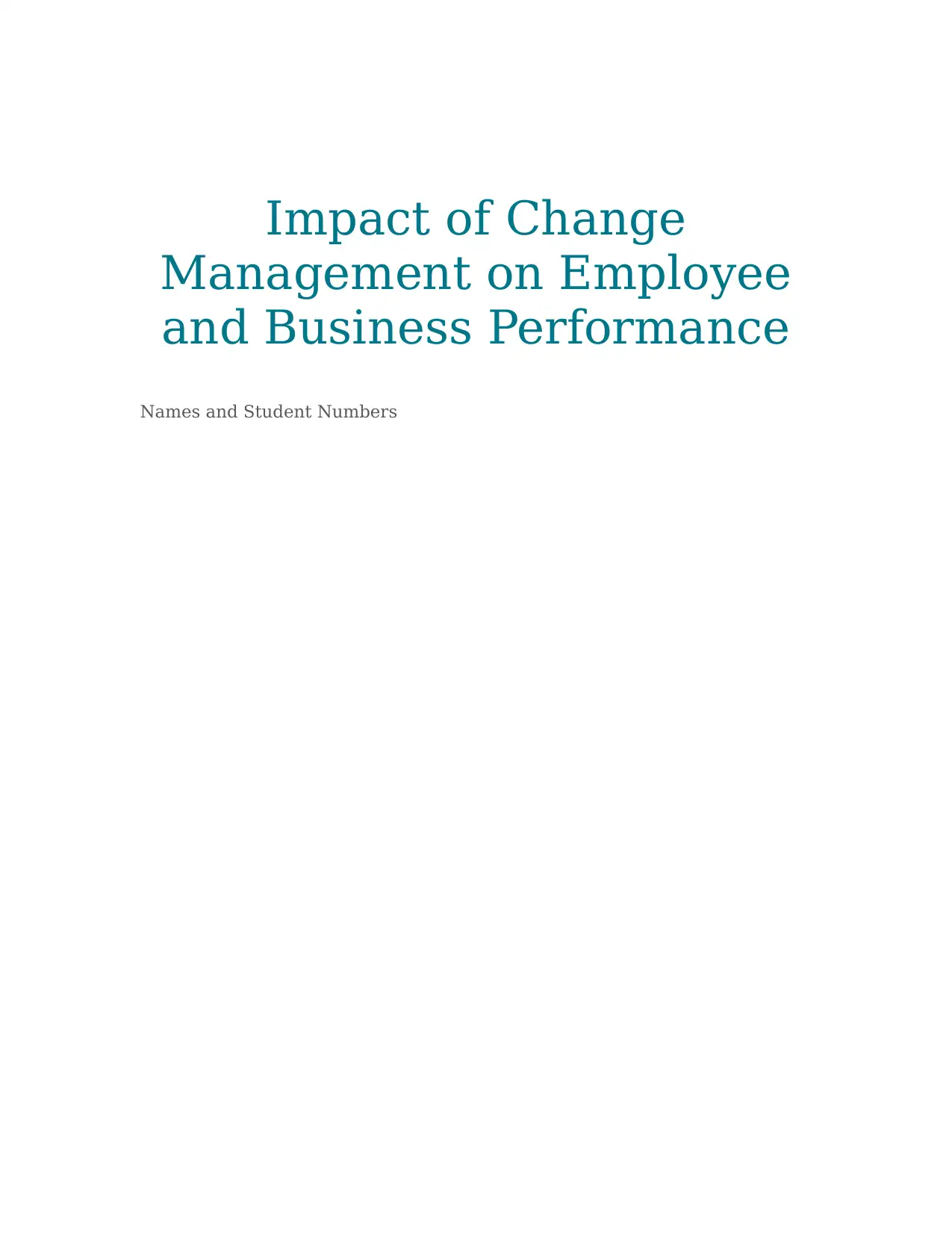
Impact of Change
Management on Employee
and Business Performance
Names and Student Numbers
Management on Employee
and Business Performance
Names and Student Numbers
Paraphrase This Document
Need a fresh take? Get an instant paraphrase of this document with our AI Paraphraser
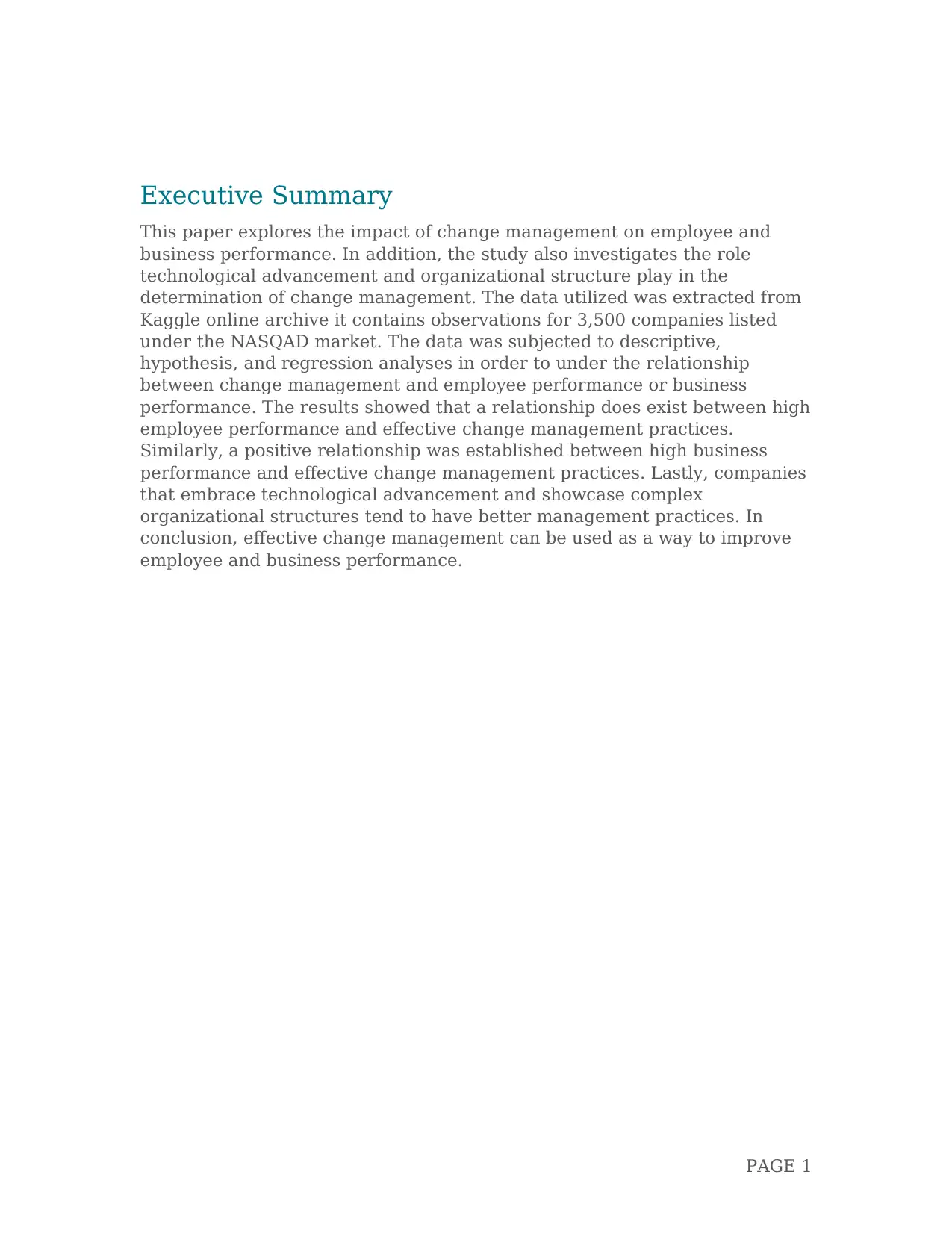
Executive Summary
This paper explores the impact of change management on employee and
business performance. In addition, the study also investigates the role
technological advancement and organizational structure play in the
determination of change management. The data utilized was extracted from
Kaggle online archive it contains observations for 3,500 companies listed
under the NASQAD market. The data was subjected to descriptive,
hypothesis, and regression analyses in order to under the relationship
between change management and employee performance or business
performance. The results showed that a relationship does exist between high
employee performance and effective change management practices.
Similarly, a positive relationship was established between high business
performance and effective change management practices. Lastly, companies
that embrace technological advancement and showcase complex
organizational structures tend to have better management practices. In
conclusion, effective change management can be used as a way to improve
employee and business performance.
PAGE 1
This paper explores the impact of change management on employee and
business performance. In addition, the study also investigates the role
technological advancement and organizational structure play in the
determination of change management. The data utilized was extracted from
Kaggle online archive it contains observations for 3,500 companies listed
under the NASQAD market. The data was subjected to descriptive,
hypothesis, and regression analyses in order to under the relationship
between change management and employee performance or business
performance. The results showed that a relationship does exist between high
employee performance and effective change management practices.
Similarly, a positive relationship was established between high business
performance and effective change management practices. Lastly, companies
that embrace technological advancement and showcase complex
organizational structures tend to have better management practices. In
conclusion, effective change management can be used as a way to improve
employee and business performance.
PAGE 1
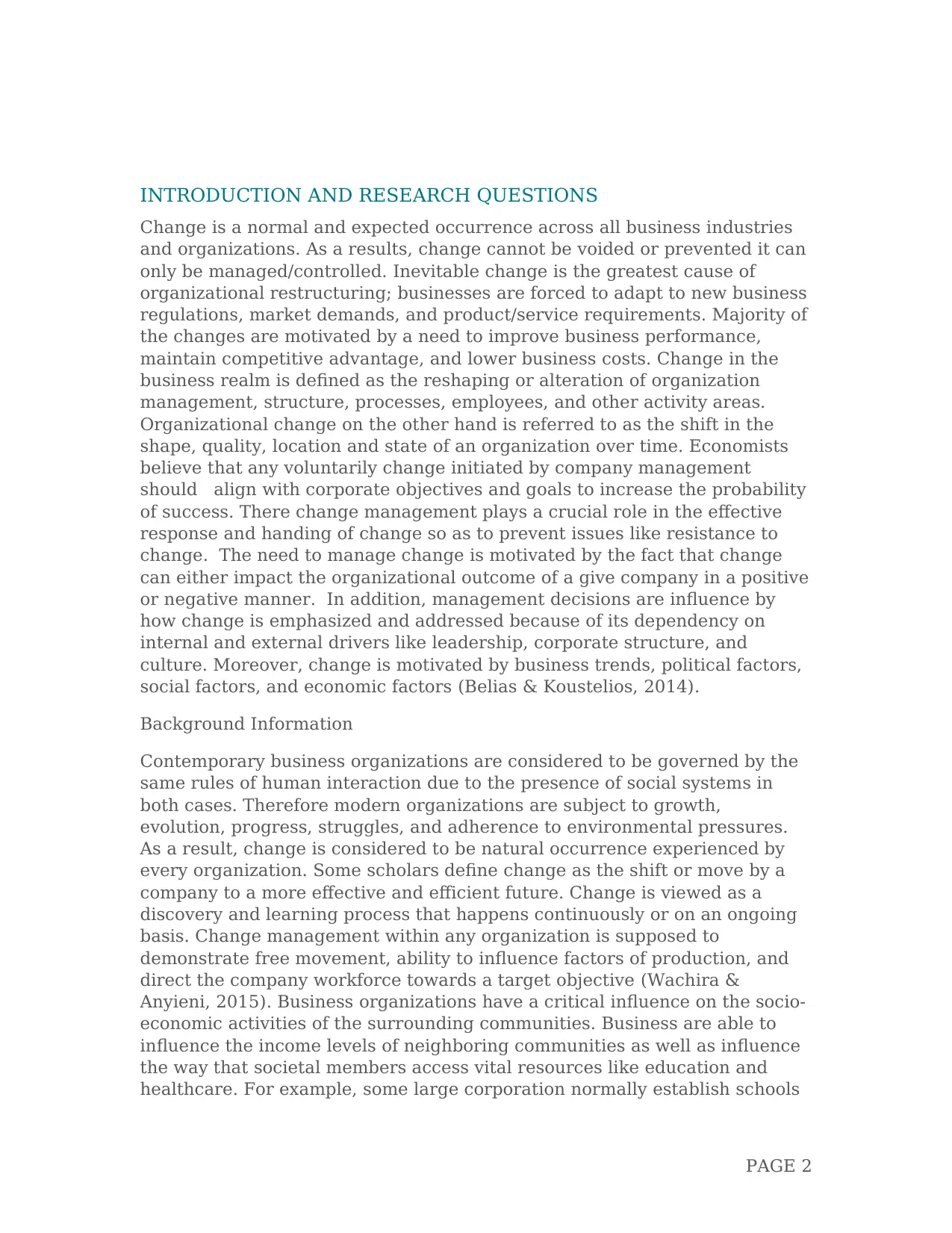
INTRODUCTION AND RESEARCH QUESTIONS
Change is a normal and expected occurrence across all business industries
and organizations. As a results, change cannot be voided or prevented it can
only be managed/controlled. Inevitable change is the greatest cause of
organizational restructuring; businesses are forced to adapt to new business
regulations, market demands, and product/service requirements. Majority of
the changes are motivated by a need to improve business performance,
maintain competitive advantage, and lower business costs. Change in the
business realm is defined as the reshaping or alteration of organization
management, structure, processes, employees, and other activity areas.
Organizational change on the other hand is referred to as the shift in the
shape, quality, location and state of an organization over time. Economists
believe that any voluntarily change initiated by company management
should align with corporate objectives and goals to increase the probability
of success. There change management plays a crucial role in the effective
response and handing of change so as to prevent issues like resistance to
change. The need to manage change is motivated by the fact that change
can either impact the organizational outcome of a give company in a positive
or negative manner. In addition, management decisions are influence by
how change is emphasized and addressed because of its dependency on
internal and external drivers like leadership, corporate structure, and
culture. Moreover, change is motivated by business trends, political factors,
social factors, and economic factors (Belias & Koustelios, 2014).
Background Information
Contemporary business organizations are considered to be governed by the
same rules of human interaction due to the presence of social systems in
both cases. Therefore modern organizations are subject to growth,
evolution, progress, struggles, and adherence to environmental pressures.
As a result, change is considered to be natural occurrence experienced by
every organization. Some scholars define change as the shift or move by a
company to a more effective and efficient future. Change is viewed as a
discovery and learning process that happens continuously or on an ongoing
basis. Change management within any organization is supposed to
demonstrate free movement, ability to influence factors of production, and
direct the company workforce towards a target objective (Wachira &
Anyieni, 2015). Business organizations have a critical influence on the socio-
economic activities of the surrounding communities. Business are able to
influence the income levels of neighboring communities as well as influence
the way that societal members access vital resources like education and
healthcare. For example, some large corporation normally establish schools
PAGE 2
Change is a normal and expected occurrence across all business industries
and organizations. As a results, change cannot be voided or prevented it can
only be managed/controlled. Inevitable change is the greatest cause of
organizational restructuring; businesses are forced to adapt to new business
regulations, market demands, and product/service requirements. Majority of
the changes are motivated by a need to improve business performance,
maintain competitive advantage, and lower business costs. Change in the
business realm is defined as the reshaping or alteration of organization
management, structure, processes, employees, and other activity areas.
Organizational change on the other hand is referred to as the shift in the
shape, quality, location and state of an organization over time. Economists
believe that any voluntarily change initiated by company management
should align with corporate objectives and goals to increase the probability
of success. There change management plays a crucial role in the effective
response and handing of change so as to prevent issues like resistance to
change. The need to manage change is motivated by the fact that change
can either impact the organizational outcome of a give company in a positive
or negative manner. In addition, management decisions are influence by
how change is emphasized and addressed because of its dependency on
internal and external drivers like leadership, corporate structure, and
culture. Moreover, change is motivated by business trends, political factors,
social factors, and economic factors (Belias & Koustelios, 2014).
Background Information
Contemporary business organizations are considered to be governed by the
same rules of human interaction due to the presence of social systems in
both cases. Therefore modern organizations are subject to growth,
evolution, progress, struggles, and adherence to environmental pressures.
As a result, change is considered to be natural occurrence experienced by
every organization. Some scholars define change as the shift or move by a
company to a more effective and efficient future. Change is viewed as a
discovery and learning process that happens continuously or on an ongoing
basis. Change management within any organization is supposed to
demonstrate free movement, ability to influence factors of production, and
direct the company workforce towards a target objective (Wachira &
Anyieni, 2015). Business organizations have a critical influence on the socio-
economic activities of the surrounding communities. Business are able to
influence the income levels of neighboring communities as well as influence
the way that societal members access vital resources like education and
healthcare. For example, some large corporation normally establish schools
PAGE 2
⊘ This is a preview!⊘
Do you want full access?
Subscribe today to unlock all pages.

Trusted by 1+ million students worldwide
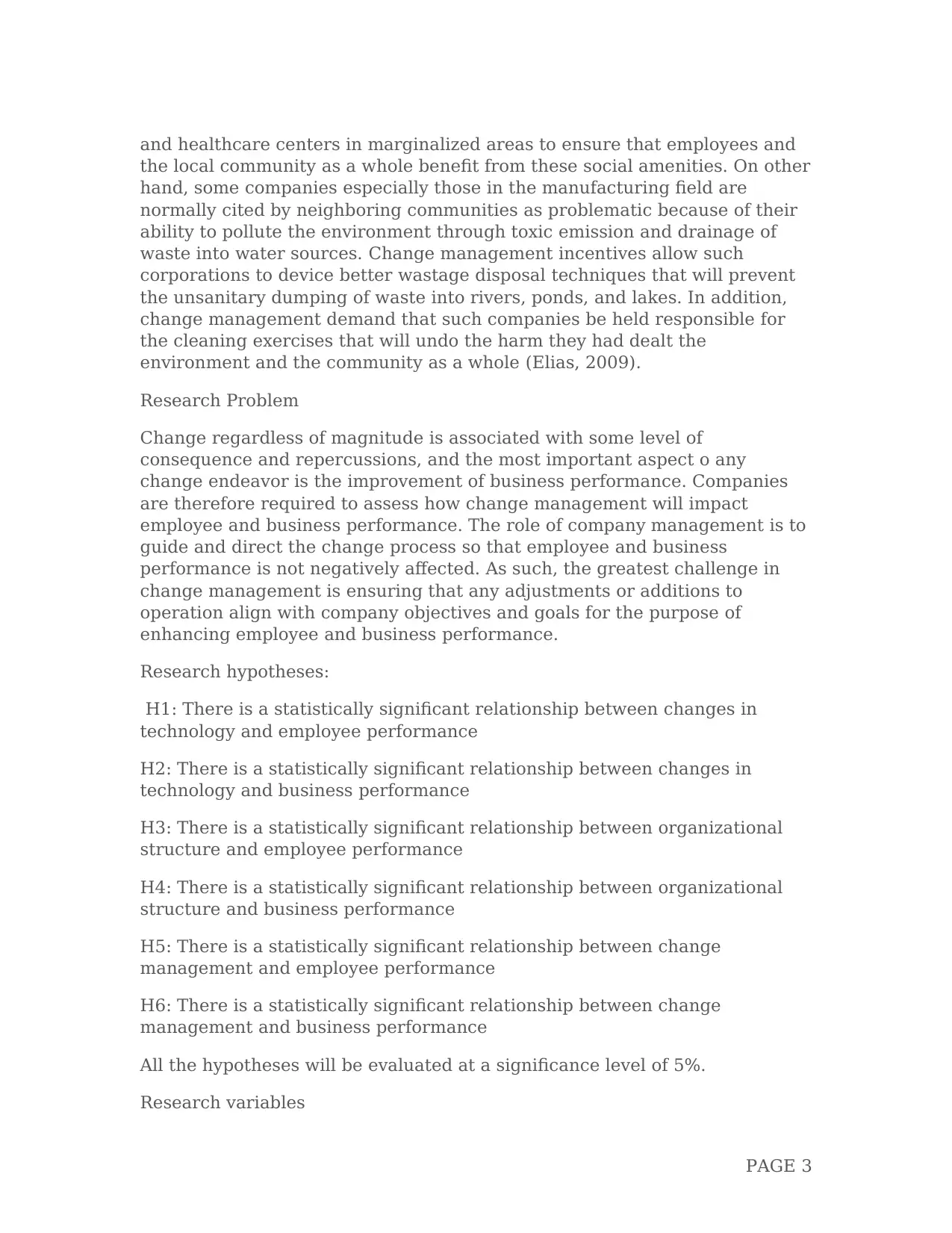
and healthcare centers in marginalized areas to ensure that employees and
the local community as a whole benefit from these social amenities. On other
hand, some companies especially those in the manufacturing field are
normally cited by neighboring communities as problematic because of their
ability to pollute the environment through toxic emission and drainage of
waste into water sources. Change management incentives allow such
corporations to device better wastage disposal techniques that will prevent
the unsanitary dumping of waste into rivers, ponds, and lakes. In addition,
change management demand that such companies be held responsible for
the cleaning exercises that will undo the harm they had dealt the
environment and the community as a whole (Elias, 2009).
Research Problem
Change regardless of magnitude is associated with some level of
consequence and repercussions, and the most important aspect o any
change endeavor is the improvement of business performance. Companies
are therefore required to assess how change management will impact
employee and business performance. The role of company management is to
guide and direct the change process so that employee and business
performance is not negatively affected. As such, the greatest challenge in
change management is ensuring that any adjustments or additions to
operation align with company objectives and goals for the purpose of
enhancing employee and business performance.
Research hypotheses:
H1: There is a statistically significant relationship between changes in
technology and employee performance
H2: There is a statistically significant relationship between changes in
technology and business performance
H3: There is a statistically significant relationship between organizational
structure and employee performance
H4: There is a statistically significant relationship between organizational
structure and business performance
H5: There is a statistically significant relationship between change
management and employee performance
H6: There is a statistically significant relationship between change
management and business performance
All the hypotheses will be evaluated at a significance level of 5%.
Research variables
PAGE 3
the local community as a whole benefit from these social amenities. On other
hand, some companies especially those in the manufacturing field are
normally cited by neighboring communities as problematic because of their
ability to pollute the environment through toxic emission and drainage of
waste into water sources. Change management incentives allow such
corporations to device better wastage disposal techniques that will prevent
the unsanitary dumping of waste into rivers, ponds, and lakes. In addition,
change management demand that such companies be held responsible for
the cleaning exercises that will undo the harm they had dealt the
environment and the community as a whole (Elias, 2009).
Research Problem
Change regardless of magnitude is associated with some level of
consequence and repercussions, and the most important aspect o any
change endeavor is the improvement of business performance. Companies
are therefore required to assess how change management will impact
employee and business performance. The role of company management is to
guide and direct the change process so that employee and business
performance is not negatively affected. As such, the greatest challenge in
change management is ensuring that any adjustments or additions to
operation align with company objectives and goals for the purpose of
enhancing employee and business performance.
Research hypotheses:
H1: There is a statistically significant relationship between changes in
technology and employee performance
H2: There is a statistically significant relationship between changes in
technology and business performance
H3: There is a statistically significant relationship between organizational
structure and employee performance
H4: There is a statistically significant relationship between organizational
structure and business performance
H5: There is a statistically significant relationship between change
management and employee performance
H6: There is a statistically significant relationship between change
management and business performance
All the hypotheses will be evaluated at a significance level of 5%.
Research variables
PAGE 3
Paraphrase This Document
Need a fresh take? Get an instant paraphrase of this document with our AI Paraphraser
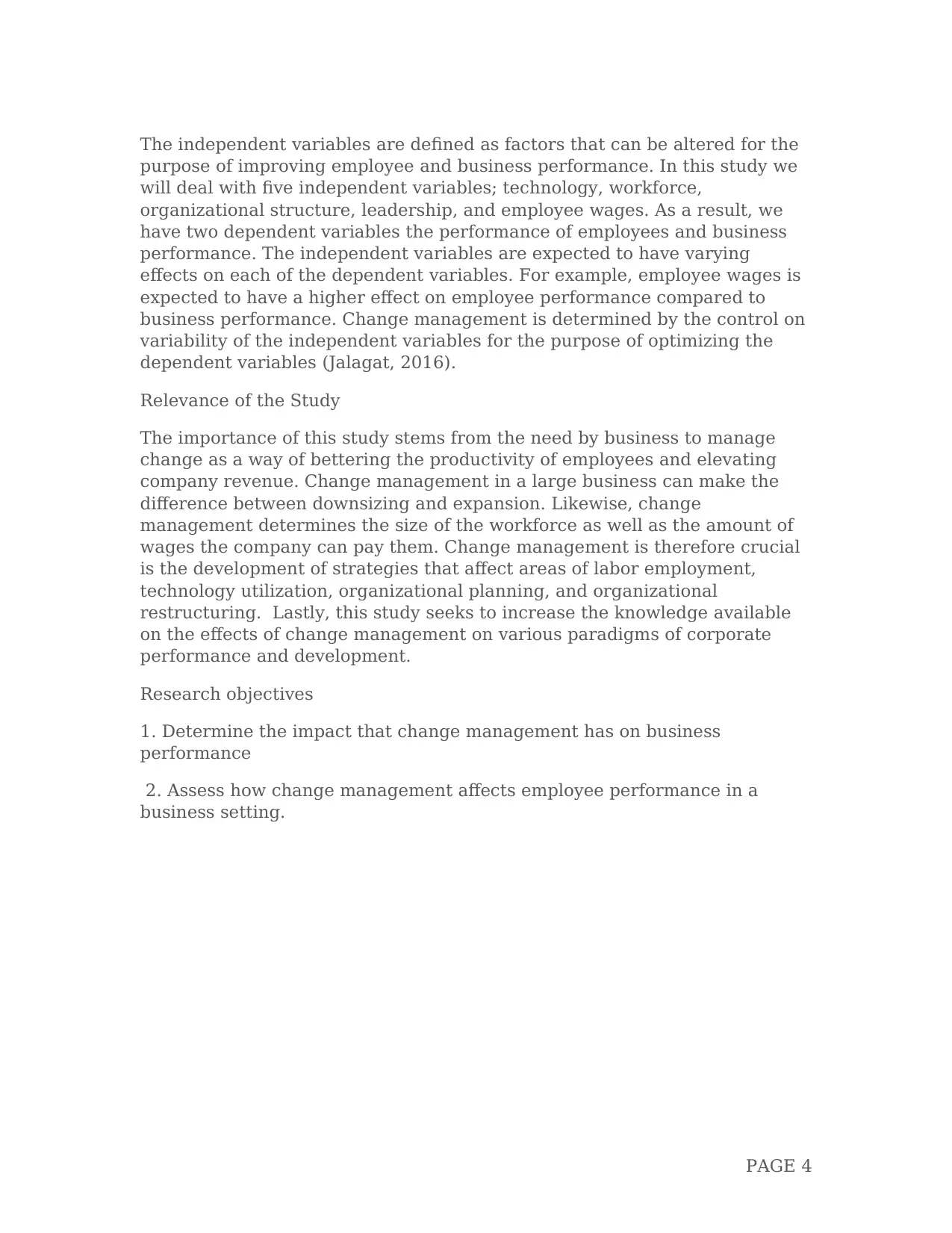
The independent variables are defined as factors that can be altered for the
purpose of improving employee and business performance. In this study we
will deal with five independent variables; technology, workforce,
organizational structure, leadership, and employee wages. As a result, we
have two dependent variables the performance of employees and business
performance. The independent variables are expected to have varying
effects on each of the dependent variables. For example, employee wages is
expected to have a higher effect on employee performance compared to
business performance. Change management is determined by the control on
variability of the independent variables for the purpose of optimizing the
dependent variables (Jalagat, 2016).
Relevance of the Study
The importance of this study stems from the need by business to manage
change as a way of bettering the productivity of employees and elevating
company revenue. Change management in a large business can make the
difference between downsizing and expansion. Likewise, change
management determines the size of the workforce as well as the amount of
wages the company can pay them. Change management is therefore crucial
is the development of strategies that affect areas of labor employment,
technology utilization, organizational planning, and organizational
restructuring. Lastly, this study seeks to increase the knowledge available
on the effects of change management on various paradigms of corporate
performance and development.
Research objectives
1. Determine the impact that change management has on business
performance
2. Assess how change management affects employee performance in a
business setting.
PAGE 4
purpose of improving employee and business performance. In this study we
will deal with five independent variables; technology, workforce,
organizational structure, leadership, and employee wages. As a result, we
have two dependent variables the performance of employees and business
performance. The independent variables are expected to have varying
effects on each of the dependent variables. For example, employee wages is
expected to have a higher effect on employee performance compared to
business performance. Change management is determined by the control on
variability of the independent variables for the purpose of optimizing the
dependent variables (Jalagat, 2016).
Relevance of the Study
The importance of this study stems from the need by business to manage
change as a way of bettering the productivity of employees and elevating
company revenue. Change management in a large business can make the
difference between downsizing and expansion. Likewise, change
management determines the size of the workforce as well as the amount of
wages the company can pay them. Change management is therefore crucial
is the development of strategies that affect areas of labor employment,
technology utilization, organizational planning, and organizational
restructuring. Lastly, this study seeks to increase the knowledge available
on the effects of change management on various paradigms of corporate
performance and development.
Research objectives
1. Determine the impact that change management has on business
performance
2. Assess how change management affects employee performance in a
business setting.
PAGE 4
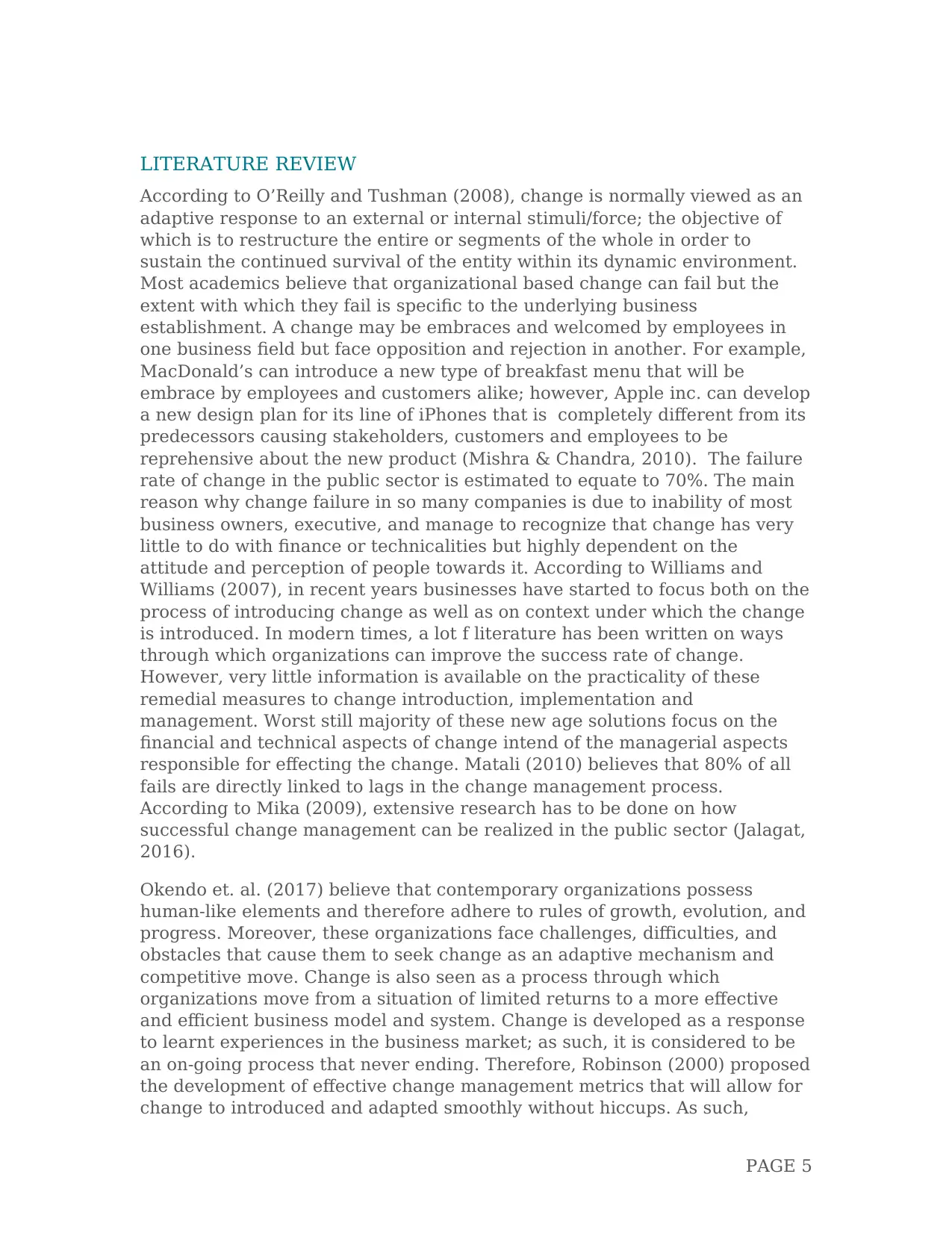
LITERATURE REVIEW
According to O’Reilly and Tushman (2008), change is normally viewed as an
adaptive response to an external or internal stimuli/force; the objective of
which is to restructure the entire or segments of the whole in order to
sustain the continued survival of the entity within its dynamic environment.
Most academics believe that organizational based change can fail but the
extent with which they fail is specific to the underlying business
establishment. A change may be embraces and welcomed by employees in
one business field but face opposition and rejection in another. For example,
MacDonald’s can introduce a new type of breakfast menu that will be
embrace by employees and customers alike; however, Apple inc. can develop
a new design plan for its line of iPhones that is completely different from its
predecessors causing stakeholders, customers and employees to be
reprehensive about the new product (Mishra & Chandra, 2010). The failure
rate of change in the public sector is estimated to equate to 70%. The main
reason why change failure in so many companies is due to inability of most
business owners, executive, and manage to recognize that change has very
little to do with finance or technicalities but highly dependent on the
attitude and perception of people towards it. According to Williams and
Williams (2007), in recent years businesses have started to focus both on the
process of introducing change as well as on context under which the change
is introduced. In modern times, a lot f literature has been written on ways
through which organizations can improve the success rate of change.
However, very little information is available on the practicality of these
remedial measures to change introduction, implementation and
management. Worst still majority of these new age solutions focus on the
financial and technical aspects of change intend of the managerial aspects
responsible for effecting the change. Matali (2010) believes that 80% of all
fails are directly linked to lags in the change management process.
According to Mika (2009), extensive research has to be done on how
successful change management can be realized in the public sector (Jalagat,
2016).
Okendo et. al. (2017) believe that contemporary organizations possess
human-like elements and therefore adhere to rules of growth, evolution, and
progress. Moreover, these organizations face challenges, difficulties, and
obstacles that cause them to seek change as an adaptive mechanism and
competitive move. Change is also seen as a process through which
organizations move from a situation of limited returns to a more effective
and efficient business model and system. Change is developed as a response
to learnt experiences in the business market; as such, it is considered to be
an on-going process that never ending. Therefore, Robinson (2000) proposed
the development of effective change management metrics that will allow for
change to introduced and adapted smoothly without hiccups. As such,
PAGE 5
According to O’Reilly and Tushman (2008), change is normally viewed as an
adaptive response to an external or internal stimuli/force; the objective of
which is to restructure the entire or segments of the whole in order to
sustain the continued survival of the entity within its dynamic environment.
Most academics believe that organizational based change can fail but the
extent with which they fail is specific to the underlying business
establishment. A change may be embraces and welcomed by employees in
one business field but face opposition and rejection in another. For example,
MacDonald’s can introduce a new type of breakfast menu that will be
embrace by employees and customers alike; however, Apple inc. can develop
a new design plan for its line of iPhones that is completely different from its
predecessors causing stakeholders, customers and employees to be
reprehensive about the new product (Mishra & Chandra, 2010). The failure
rate of change in the public sector is estimated to equate to 70%. The main
reason why change failure in so many companies is due to inability of most
business owners, executive, and manage to recognize that change has very
little to do with finance or technicalities but highly dependent on the
attitude and perception of people towards it. According to Williams and
Williams (2007), in recent years businesses have started to focus both on the
process of introducing change as well as on context under which the change
is introduced. In modern times, a lot f literature has been written on ways
through which organizations can improve the success rate of change.
However, very little information is available on the practicality of these
remedial measures to change introduction, implementation and
management. Worst still majority of these new age solutions focus on the
financial and technical aspects of change intend of the managerial aspects
responsible for effecting the change. Matali (2010) believes that 80% of all
fails are directly linked to lags in the change management process.
According to Mika (2009), extensive research has to be done on how
successful change management can be realized in the public sector (Jalagat,
2016).
Okendo et. al. (2017) believe that contemporary organizations possess
human-like elements and therefore adhere to rules of growth, evolution, and
progress. Moreover, these organizations face challenges, difficulties, and
obstacles that cause them to seek change as an adaptive mechanism and
competitive move. Change is also seen as a process through which
organizations move from a situation of limited returns to a more effective
and efficient business model and system. Change is developed as a response
to learnt experiences in the business market; as such, it is considered to be
an on-going process that never ending. Therefore, Robinson (2000) proposed
the development of effective change management metrics that will allow for
change to introduced and adapted smoothly without hiccups. As such,
PAGE 5
⊘ This is a preview!⊘
Do you want full access?
Subscribe today to unlock all pages.

Trusted by 1+ million students worldwide
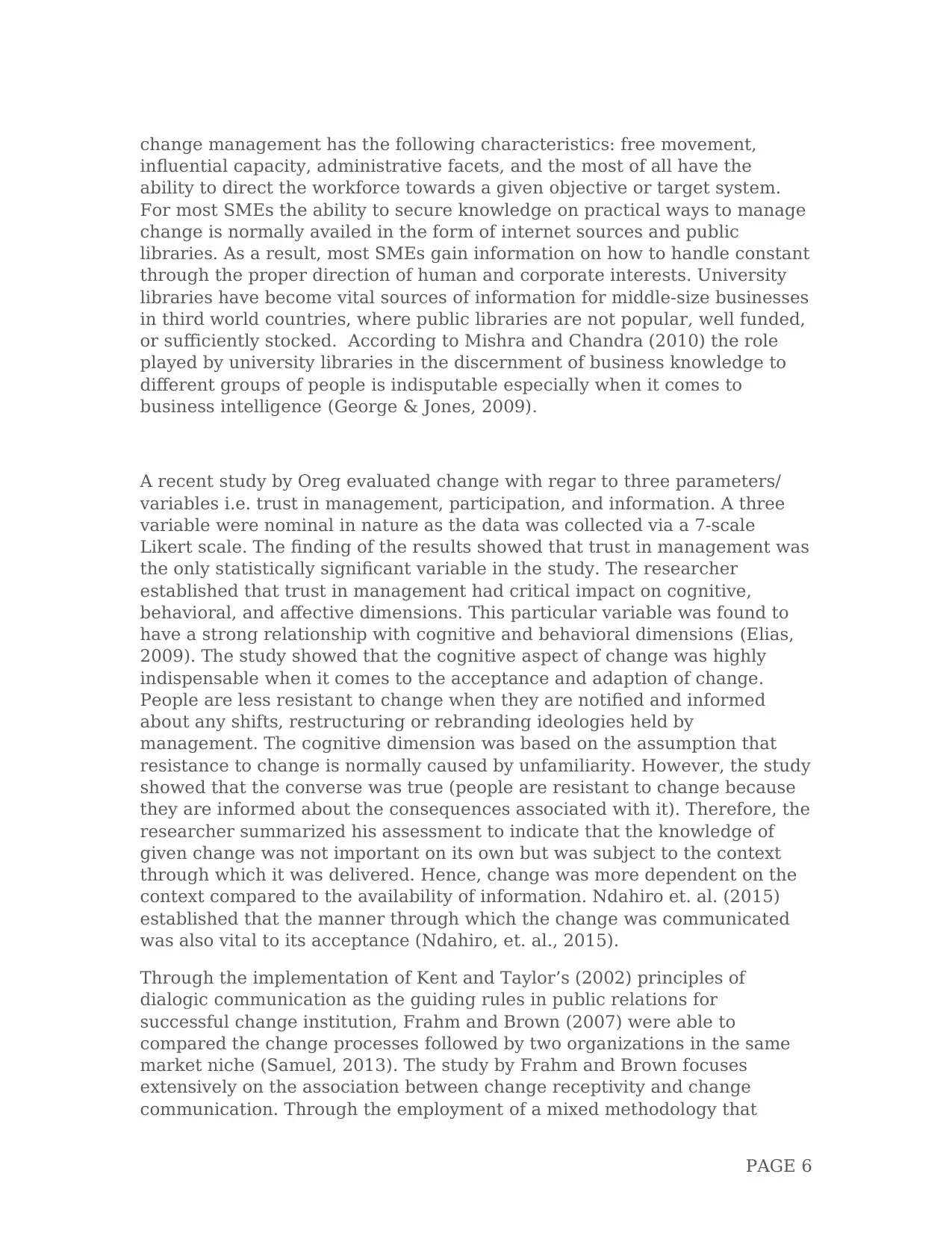
change management has the following characteristics: free movement,
influential capacity, administrative facets, and the most of all have the
ability to direct the workforce towards a given objective or target system.
For most SMEs the ability to secure knowledge on practical ways to manage
change is normally availed in the form of internet sources and public
libraries. As a result, most SMEs gain information on how to handle constant
through the proper direction of human and corporate interests. University
libraries have become vital sources of information for middle-size businesses
in third world countries, where public libraries are not popular, well funded,
or sufficiently stocked. According to Mishra and Chandra (2010) the role
played by university libraries in the discernment of business knowledge to
different groups of people is indisputable especially when it comes to
business intelligence (George & Jones, 2009).
A recent study by Oreg evaluated change with regar to three parameters/
variables i.e. trust in management, participation, and information. A three
variable were nominal in nature as the data was collected via a 7-scale
Likert scale. The finding of the results showed that trust in management was
the only statistically significant variable in the study. The researcher
established that trust in management had critical impact on cognitive,
behavioral, and affective dimensions. This particular variable was found to
have a strong relationship with cognitive and behavioral dimensions (Elias,
2009). The study showed that the cognitive aspect of change was highly
indispensable when it comes to the acceptance and adaption of change.
People are less resistant to change when they are notified and informed
about any shifts, restructuring or rebranding ideologies held by
management. The cognitive dimension was based on the assumption that
resistance to change is normally caused by unfamiliarity. However, the study
showed that the converse was true (people are resistant to change because
they are informed about the consequences associated with it). Therefore, the
researcher summarized his assessment to indicate that the knowledge of
given change was not important on its own but was subject to the context
through which it was delivered. Hence, change was more dependent on the
context compared to the availability of information. Ndahiro et. al. (2015)
established that the manner through which the change was communicated
was also vital to its acceptance (Ndahiro, et. al., 2015).
Through the implementation of Kent and Taylor’s (2002) principles of
dialogic communication as the guiding rules in public relations for
successful change institution, Frahm and Brown (2007) were able to
compared the change processes followed by two organizations in the same
market niche (Samuel, 2013). The study by Frahm and Brown focuses
extensively on the association between change receptivity and change
communication. Through the employment of a mixed methodology that
PAGE 6
influential capacity, administrative facets, and the most of all have the
ability to direct the workforce towards a given objective or target system.
For most SMEs the ability to secure knowledge on practical ways to manage
change is normally availed in the form of internet sources and public
libraries. As a result, most SMEs gain information on how to handle constant
through the proper direction of human and corporate interests. University
libraries have become vital sources of information for middle-size businesses
in third world countries, where public libraries are not popular, well funded,
or sufficiently stocked. According to Mishra and Chandra (2010) the role
played by university libraries in the discernment of business knowledge to
different groups of people is indisputable especially when it comes to
business intelligence (George & Jones, 2009).
A recent study by Oreg evaluated change with regar to three parameters/
variables i.e. trust in management, participation, and information. A three
variable were nominal in nature as the data was collected via a 7-scale
Likert scale. The finding of the results showed that trust in management was
the only statistically significant variable in the study. The researcher
established that trust in management had critical impact on cognitive,
behavioral, and affective dimensions. This particular variable was found to
have a strong relationship with cognitive and behavioral dimensions (Elias,
2009). The study showed that the cognitive aspect of change was highly
indispensable when it comes to the acceptance and adaption of change.
People are less resistant to change when they are notified and informed
about any shifts, restructuring or rebranding ideologies held by
management. The cognitive dimension was based on the assumption that
resistance to change is normally caused by unfamiliarity. However, the study
showed that the converse was true (people are resistant to change because
they are informed about the consequences associated with it). Therefore, the
researcher summarized his assessment to indicate that the knowledge of
given change was not important on its own but was subject to the context
through which it was delivered. Hence, change was more dependent on the
context compared to the availability of information. Ndahiro et. al. (2015)
established that the manner through which the change was communicated
was also vital to its acceptance (Ndahiro, et. al., 2015).
Through the implementation of Kent and Taylor’s (2002) principles of
dialogic communication as the guiding rules in public relations for
successful change institution, Frahm and Brown (2007) were able to
compared the change processes followed by two organizations in the same
market niche (Samuel, 2013). The study by Frahm and Brown focuses
extensively on the association between change receptivity and change
communication. Through the employment of a mixed methodology that
PAGE 6
Paraphrase This Document
Need a fresh take? Get an instant paraphrase of this document with our AI Paraphraser
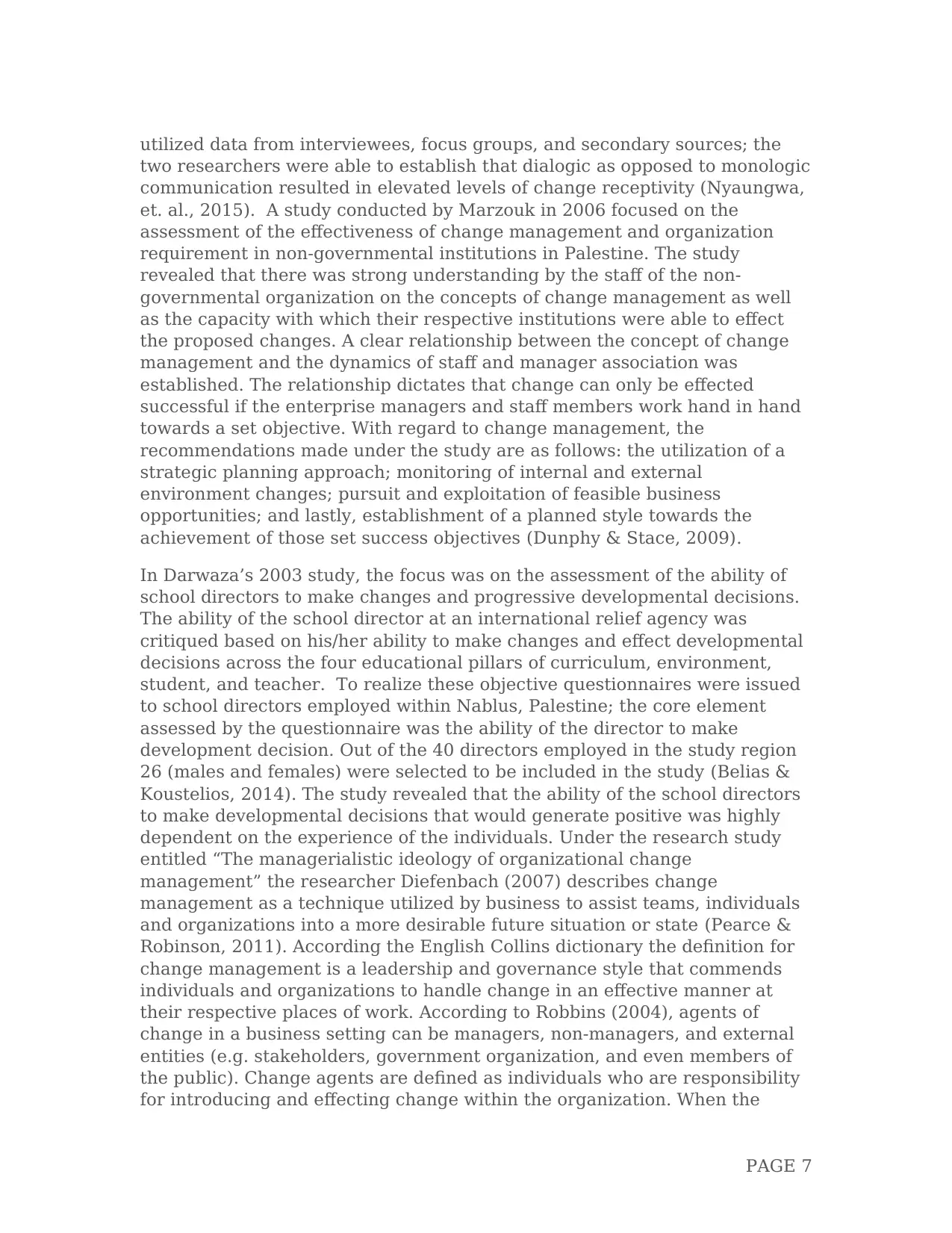
utilized data from interviewees, focus groups, and secondary sources; the
two researchers were able to establish that dialogic as opposed to monologic
communication resulted in elevated levels of change receptivity (Nyaungwa,
et. al., 2015). A study conducted by Marzouk in 2006 focused on the
assessment of the effectiveness of change management and organization
requirement in non-governmental institutions in Palestine. The study
revealed that there was strong understanding by the staff of the non-
governmental organization on the concepts of change management as well
as the capacity with which their respective institutions were able to effect
the proposed changes. A clear relationship between the concept of change
management and the dynamics of staff and manager association was
established. The relationship dictates that change can only be effected
successful if the enterprise managers and staff members work hand in hand
towards a set objective. With regard to change management, the
recommendations made under the study are as follows: the utilization of a
strategic planning approach; monitoring of internal and external
environment changes; pursuit and exploitation of feasible business
opportunities; and lastly, establishment of a planned style towards the
achievement of those set success objectives (Dunphy & Stace, 2009).
In Darwaza’s 2003 study, the focus was on the assessment of the ability of
school directors to make changes and progressive developmental decisions.
The ability of the school director at an international relief agency was
critiqued based on his/her ability to make changes and effect developmental
decisions across the four educational pillars of curriculum, environment,
student, and teacher. To realize these objective questionnaires were issued
to school directors employed within Nablus, Palestine; the core element
assessed by the questionnaire was the ability of the director to make
development decision. Out of the 40 directors employed in the study region
26 (males and females) were selected to be included in the study (Belias &
Koustelios, 2014). The study revealed that the ability of the school directors
to make developmental decisions that would generate positive was highly
dependent on the experience of the individuals. Under the research study
entitled “The managerialistic ideology of organizational change
management” the researcher Diefenbach (2007) describes change
management as a technique utilized by business to assist teams, individuals
and organizations into a more desirable future situation or state (Pearce &
Robinson, 2011). According the English Collins dictionary the definition for
change management is a leadership and governance style that commends
individuals and organizations to handle change in an effective manner at
their respective places of work. According to Robbins (2004), agents of
change in a business setting can be managers, non-managers, and external
entities (e.g. stakeholders, government organization, and even members of
the public). Change agents are defined as individuals who are responsibility
for introducing and effecting change within the organization. When the
PAGE 7
two researchers were able to establish that dialogic as opposed to monologic
communication resulted in elevated levels of change receptivity (Nyaungwa,
et. al., 2015). A study conducted by Marzouk in 2006 focused on the
assessment of the effectiveness of change management and organization
requirement in non-governmental institutions in Palestine. The study
revealed that there was strong understanding by the staff of the non-
governmental organization on the concepts of change management as well
as the capacity with which their respective institutions were able to effect
the proposed changes. A clear relationship between the concept of change
management and the dynamics of staff and manager association was
established. The relationship dictates that change can only be effected
successful if the enterprise managers and staff members work hand in hand
towards a set objective. With regard to change management, the
recommendations made under the study are as follows: the utilization of a
strategic planning approach; monitoring of internal and external
environment changes; pursuit and exploitation of feasible business
opportunities; and lastly, establishment of a planned style towards the
achievement of those set success objectives (Dunphy & Stace, 2009).
In Darwaza’s 2003 study, the focus was on the assessment of the ability of
school directors to make changes and progressive developmental decisions.
The ability of the school director at an international relief agency was
critiqued based on his/her ability to make changes and effect developmental
decisions across the four educational pillars of curriculum, environment,
student, and teacher. To realize these objective questionnaires were issued
to school directors employed within Nablus, Palestine; the core element
assessed by the questionnaire was the ability of the director to make
development decision. Out of the 40 directors employed in the study region
26 (males and females) were selected to be included in the study (Belias &
Koustelios, 2014). The study revealed that the ability of the school directors
to make developmental decisions that would generate positive was highly
dependent on the experience of the individuals. Under the research study
entitled “The managerialistic ideology of organizational change
management” the researcher Diefenbach (2007) describes change
management as a technique utilized by business to assist teams, individuals
and organizations into a more desirable future situation or state (Pearce &
Robinson, 2011). According the English Collins dictionary the definition for
change management is a leadership and governance style that commends
individuals and organizations to handle change in an effective manner at
their respective places of work. According to Robbins (2004), agents of
change in a business setting can be managers, non-managers, and external
entities (e.g. stakeholders, government organization, and even members of
the public). Change agents are defined as individuals who are responsibility
for introducing and effecting change within the organization. When the
PAGE 7
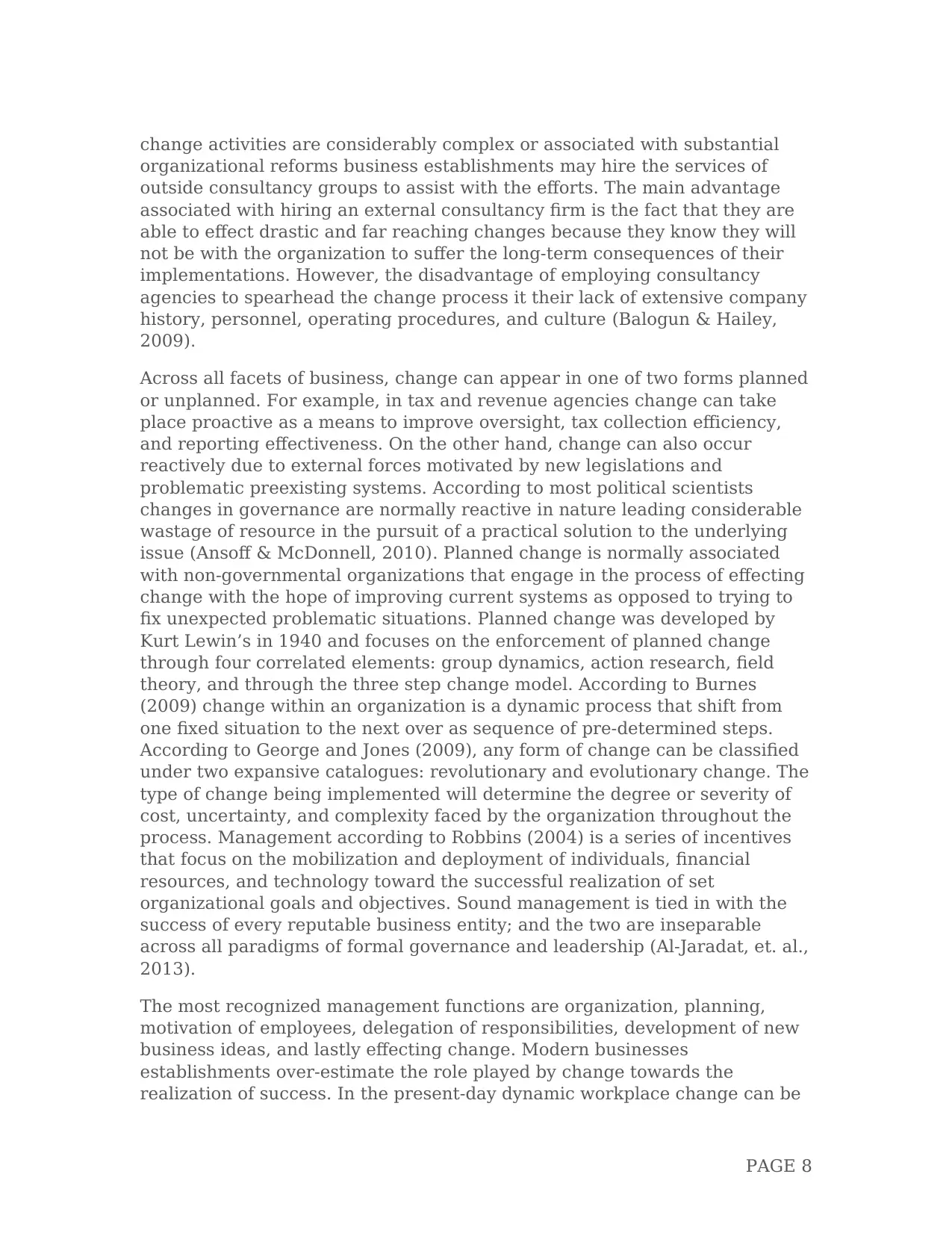
change activities are considerably complex or associated with substantial
organizational reforms business establishments may hire the services of
outside consultancy groups to assist with the efforts. The main advantage
associated with hiring an external consultancy firm is the fact that they are
able to effect drastic and far reaching changes because they know they will
not be with the organization to suffer the long-term consequences of their
implementations. However, the disadvantage of employing consultancy
agencies to spearhead the change process it their lack of extensive company
history, personnel, operating procedures, and culture (Balogun & Hailey,
2009).
Across all facets of business, change can appear in one of two forms planned
or unplanned. For example, in tax and revenue agencies change can take
place proactive as a means to improve oversight, tax collection efficiency,
and reporting effectiveness. On the other hand, change can also occur
reactively due to external forces motivated by new legislations and
problematic preexisting systems. According to most political scientists
changes in governance are normally reactive in nature leading considerable
wastage of resource in the pursuit of a practical solution to the underlying
issue (Ansoff & McDonnell, 2010). Planned change is normally associated
with non-governmental organizations that engage in the process of effecting
change with the hope of improving current systems as opposed to trying to
fix unexpected problematic situations. Planned change was developed by
Kurt Lewin’s in 1940 and focuses on the enforcement of planned change
through four correlated elements: group dynamics, action research, field
theory, and through the three step change model. According to Burnes
(2009) change within an organization is a dynamic process that shift from
one fixed situation to the next over as sequence of pre-determined steps.
According to George and Jones (2009), any form of change can be classified
under two expansive catalogues: revolutionary and evolutionary change. The
type of change being implemented will determine the degree or severity of
cost, uncertainty, and complexity faced by the organization throughout the
process. Management according to Robbins (2004) is a series of incentives
that focus on the mobilization and deployment of individuals, financial
resources, and technology toward the successful realization of set
organizational goals and objectives. Sound management is tied in with the
success of every reputable business entity; and the two are inseparable
across all paradigms of formal governance and leadership (Al-Jaradat, et. al.,
2013).
The most recognized management functions are organization, planning,
motivation of employees, delegation of responsibilities, development of new
business ideas, and lastly effecting change. Modern businesses
establishments over-estimate the role played by change towards the
realization of success. In the present-day dynamic workplace change can be
PAGE 8
organizational reforms business establishments may hire the services of
outside consultancy groups to assist with the efforts. The main advantage
associated with hiring an external consultancy firm is the fact that they are
able to effect drastic and far reaching changes because they know they will
not be with the organization to suffer the long-term consequences of their
implementations. However, the disadvantage of employing consultancy
agencies to spearhead the change process it their lack of extensive company
history, personnel, operating procedures, and culture (Balogun & Hailey,
2009).
Across all facets of business, change can appear in one of two forms planned
or unplanned. For example, in tax and revenue agencies change can take
place proactive as a means to improve oversight, tax collection efficiency,
and reporting effectiveness. On the other hand, change can also occur
reactively due to external forces motivated by new legislations and
problematic preexisting systems. According to most political scientists
changes in governance are normally reactive in nature leading considerable
wastage of resource in the pursuit of a practical solution to the underlying
issue (Ansoff & McDonnell, 2010). Planned change is normally associated
with non-governmental organizations that engage in the process of effecting
change with the hope of improving current systems as opposed to trying to
fix unexpected problematic situations. Planned change was developed by
Kurt Lewin’s in 1940 and focuses on the enforcement of planned change
through four correlated elements: group dynamics, action research, field
theory, and through the three step change model. According to Burnes
(2009) change within an organization is a dynamic process that shift from
one fixed situation to the next over as sequence of pre-determined steps.
According to George and Jones (2009), any form of change can be classified
under two expansive catalogues: revolutionary and evolutionary change. The
type of change being implemented will determine the degree or severity of
cost, uncertainty, and complexity faced by the organization throughout the
process. Management according to Robbins (2004) is a series of incentives
that focus on the mobilization and deployment of individuals, financial
resources, and technology toward the successful realization of set
organizational goals and objectives. Sound management is tied in with the
success of every reputable business entity; and the two are inseparable
across all paradigms of formal governance and leadership (Al-Jaradat, et. al.,
2013).
The most recognized management functions are organization, planning,
motivation of employees, delegation of responsibilities, development of new
business ideas, and lastly effecting change. Modern businesses
establishments over-estimate the role played by change towards the
realization of success. In the present-day dynamic workplace change can be
PAGE 8
⊘ This is a preview!⊘
Do you want full access?
Subscribe today to unlock all pages.

Trusted by 1+ million students worldwide
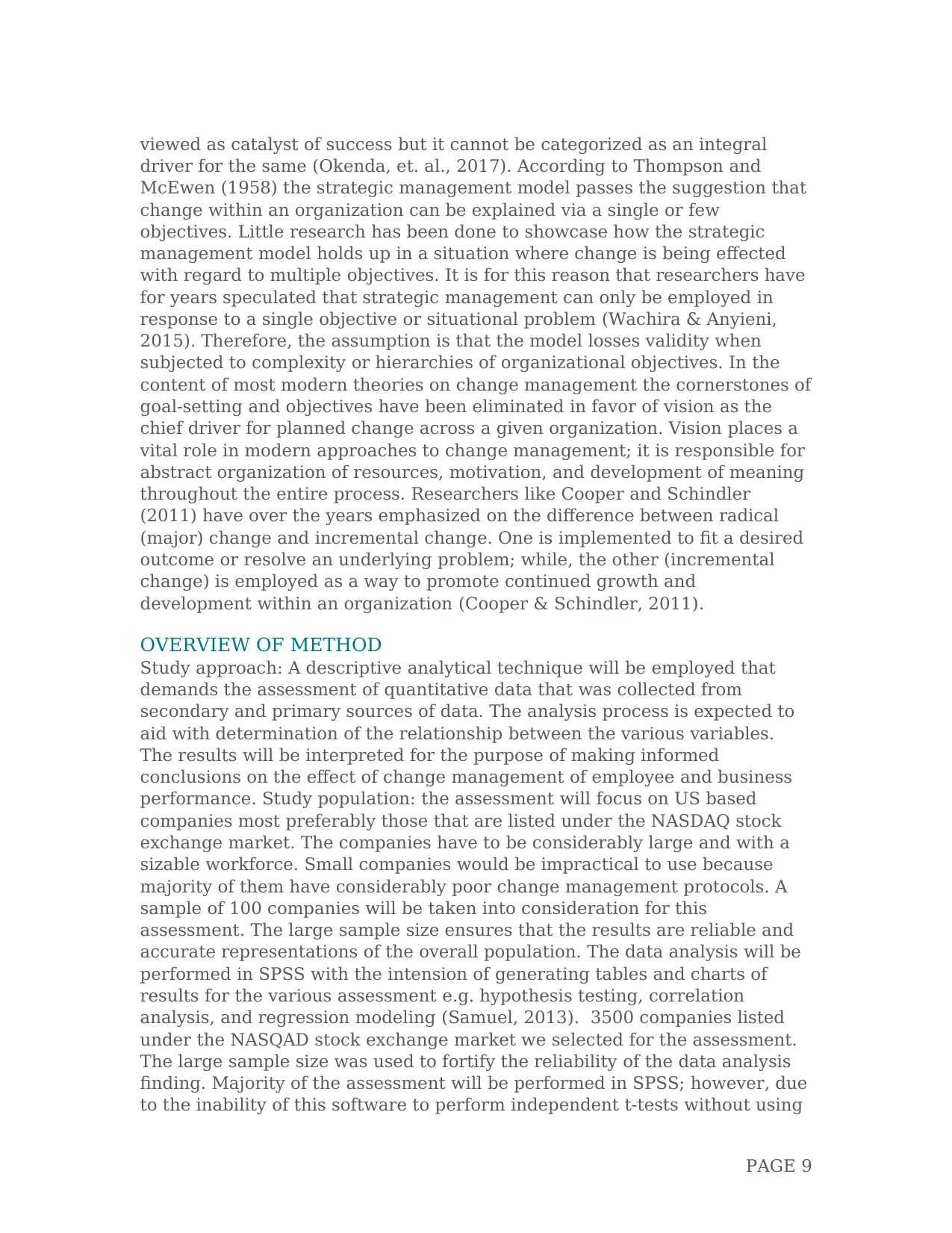
viewed as catalyst of success but it cannot be categorized as an integral
driver for the same (Okenda, et. al., 2017). According to Thompson and
McEwen (1958) the strategic management model passes the suggestion that
change within an organization can be explained via a single or few
objectives. Little research has been done to showcase how the strategic
management model holds up in a situation where change is being effected
with regard to multiple objectives. It is for this reason that researchers have
for years speculated that strategic management can only be employed in
response to a single objective or situational problem (Wachira & Anyieni,
2015). Therefore, the assumption is that the model losses validity when
subjected to complexity or hierarchies of organizational objectives. In the
content of most modern theories on change management the cornerstones of
goal-setting and objectives have been eliminated in favor of vision as the
chief driver for planned change across a given organization. Vision places a
vital role in modern approaches to change management; it is responsible for
abstract organization of resources, motivation, and development of meaning
throughout the entire process. Researchers like Cooper and Schindler
(2011) have over the years emphasized on the difference between radical
(major) change and incremental change. One is implemented to fit a desired
outcome or resolve an underlying problem; while, the other (incremental
change) is employed as a way to promote continued growth and
development within an organization (Cooper & Schindler, 2011).
OVERVIEW OF METHOD
Study approach: A descriptive analytical technique will be employed that
demands the assessment of quantitative data that was collected from
secondary and primary sources of data. The analysis process is expected to
aid with determination of the relationship between the various variables.
The results will be interpreted for the purpose of making informed
conclusions on the effect of change management of employee and business
performance. Study population: the assessment will focus on US based
companies most preferably those that are listed under the NASDAQ stock
exchange market. The companies have to be considerably large and with a
sizable workforce. Small companies would be impractical to use because
majority of them have considerably poor change management protocols. A
sample of 100 companies will be taken into consideration for this
assessment. The large sample size ensures that the results are reliable and
accurate representations of the overall population. The data analysis will be
performed in SPSS with the intension of generating tables and charts of
results for the various assessment e.g. hypothesis testing, correlation
analysis, and regression modeling (Samuel, 2013). 3500 companies listed
under the NASQAD stock exchange market we selected for the assessment.
The large sample size was used to fortify the reliability of the data analysis
finding. Majority of the assessment will be performed in SPSS; however, due
to the inability of this software to perform independent t-tests without using
PAGE 9
driver for the same (Okenda, et. al., 2017). According to Thompson and
McEwen (1958) the strategic management model passes the suggestion that
change within an organization can be explained via a single or few
objectives. Little research has been done to showcase how the strategic
management model holds up in a situation where change is being effected
with regard to multiple objectives. It is for this reason that researchers have
for years speculated that strategic management can only be employed in
response to a single objective or situational problem (Wachira & Anyieni,
2015). Therefore, the assumption is that the model losses validity when
subjected to complexity or hierarchies of organizational objectives. In the
content of most modern theories on change management the cornerstones of
goal-setting and objectives have been eliminated in favor of vision as the
chief driver for planned change across a given organization. Vision places a
vital role in modern approaches to change management; it is responsible for
abstract organization of resources, motivation, and development of meaning
throughout the entire process. Researchers like Cooper and Schindler
(2011) have over the years emphasized on the difference between radical
(major) change and incremental change. One is implemented to fit a desired
outcome or resolve an underlying problem; while, the other (incremental
change) is employed as a way to promote continued growth and
development within an organization (Cooper & Schindler, 2011).
OVERVIEW OF METHOD
Study approach: A descriptive analytical technique will be employed that
demands the assessment of quantitative data that was collected from
secondary and primary sources of data. The analysis process is expected to
aid with determination of the relationship between the various variables.
The results will be interpreted for the purpose of making informed
conclusions on the effect of change management of employee and business
performance. Study population: the assessment will focus on US based
companies most preferably those that are listed under the NASDAQ stock
exchange market. The companies have to be considerably large and with a
sizable workforce. Small companies would be impractical to use because
majority of them have considerably poor change management protocols. A
sample of 100 companies will be taken into consideration for this
assessment. The large sample size ensures that the results are reliable and
accurate representations of the overall population. The data analysis will be
performed in SPSS with the intension of generating tables and charts of
results for the various assessment e.g. hypothesis testing, correlation
analysis, and regression modeling (Samuel, 2013). 3500 companies listed
under the NASQAD stock exchange market we selected for the assessment.
The large sample size was used to fortify the reliability of the data analysis
finding. Majority of the assessment will be performed in SPSS; however, due
to the inability of this software to perform independent t-tests without using
PAGE 9
Paraphrase This Document
Need a fresh take? Get an instant paraphrase of this document with our AI Paraphraser
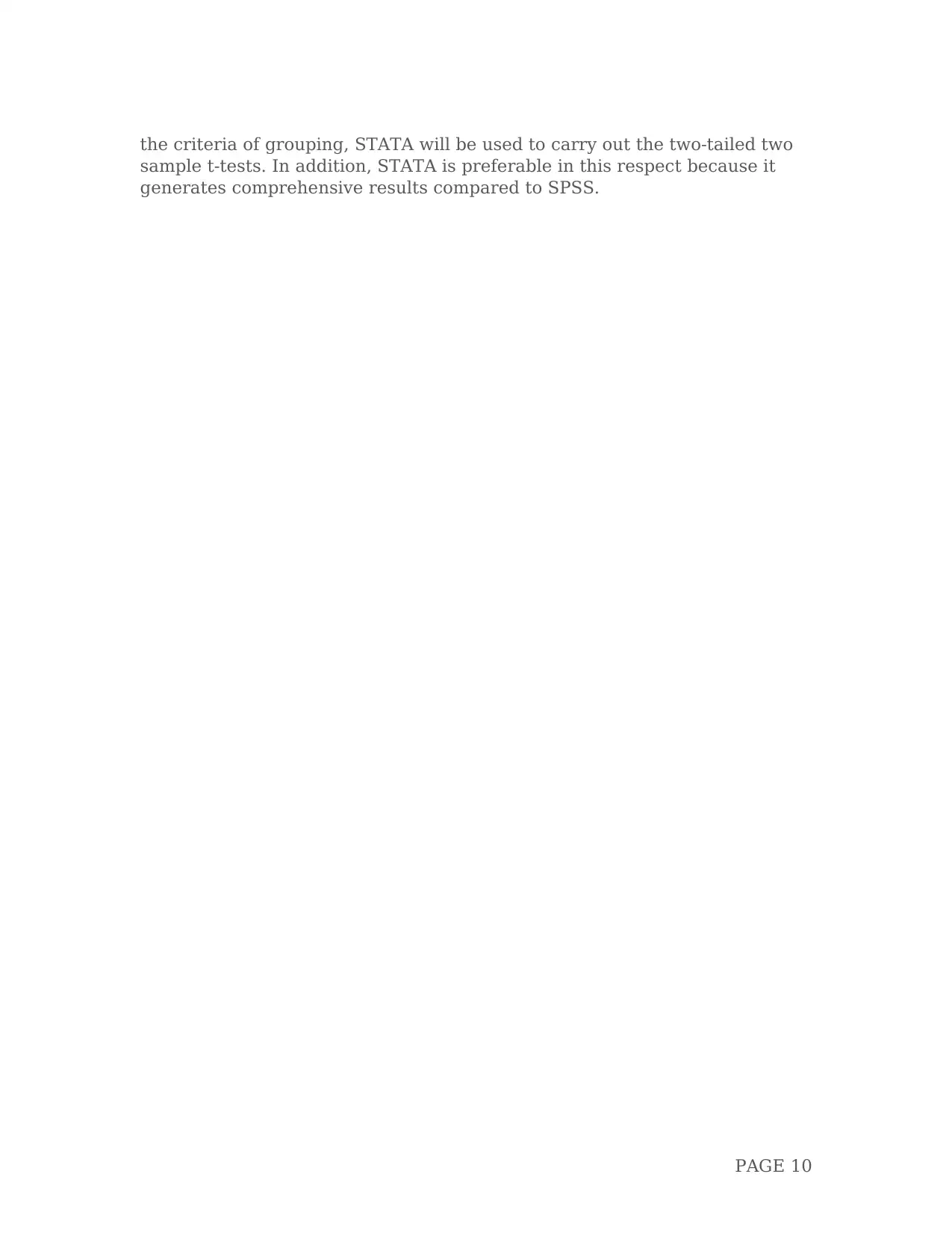
the criteria of grouping, STATA will be used to carry out the two-tailed two
sample t-tests. In addition, STATA is preferable in this respect because it
generates comprehensive results compared to SPSS.
PAGE 10
sample t-tests. In addition, STATA is preferable in this respect because it
generates comprehensive results compared to SPSS.
PAGE 10
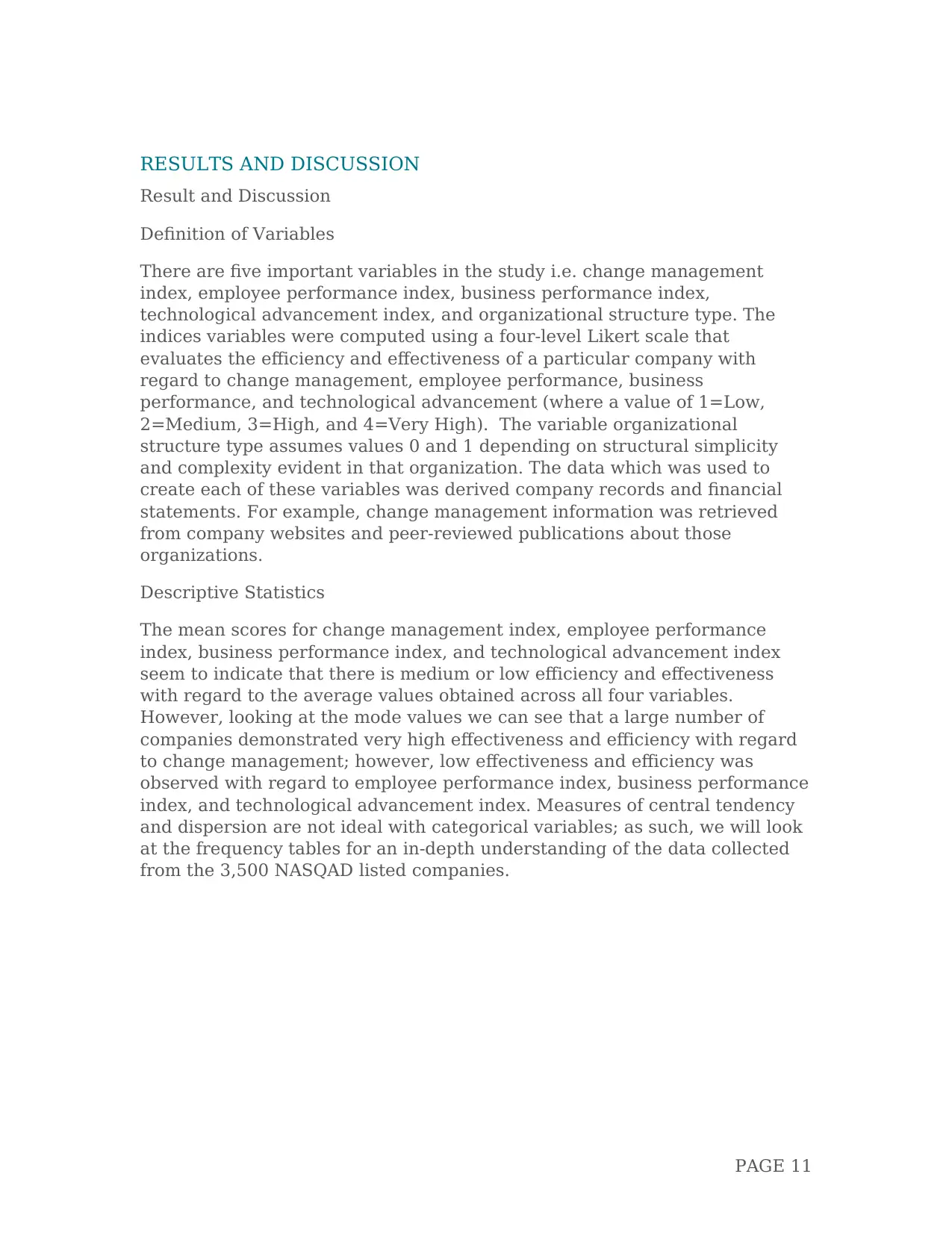
RESULTS AND DISCUSSION
Result and Discussion
Definition of Variables
There are five important variables in the study i.e. change management
index, employee performance index, business performance index,
technological advancement index, and organizational structure type. The
indices variables were computed using a four-level Likert scale that
evaluates the efficiency and effectiveness of a particular company with
regard to change management, employee performance, business
performance, and technological advancement (where a value of 1=Low,
2=Medium, 3=High, and 4=Very High). The variable organizational
structure type assumes values 0 and 1 depending on structural simplicity
and complexity evident in that organization. The data which was used to
create each of these variables was derived company records and financial
statements. For example, change management information was retrieved
from company websites and peer-reviewed publications about those
organizations.
Descriptive Statistics
The mean scores for change management index, employee performance
index, business performance index, and technological advancement index
seem to indicate that there is medium or low efficiency and effectiveness
with regard to the average values obtained across all four variables.
However, looking at the mode values we can see that a large number of
companies demonstrated very high effectiveness and efficiency with regard
to change management; however, low effectiveness and efficiency was
observed with regard to employee performance index, business performance
index, and technological advancement index. Measures of central tendency
and dispersion are not ideal with categorical variables; as such, we will look
at the frequency tables for an in-depth understanding of the data collected
from the 3,500 NASQAD listed companies.
PAGE 11
Result and Discussion
Definition of Variables
There are five important variables in the study i.e. change management
index, employee performance index, business performance index,
technological advancement index, and organizational structure type. The
indices variables were computed using a four-level Likert scale that
evaluates the efficiency and effectiveness of a particular company with
regard to change management, employee performance, business
performance, and technological advancement (where a value of 1=Low,
2=Medium, 3=High, and 4=Very High). The variable organizational
structure type assumes values 0 and 1 depending on structural simplicity
and complexity evident in that organization. The data which was used to
create each of these variables was derived company records and financial
statements. For example, change management information was retrieved
from company websites and peer-reviewed publications about those
organizations.
Descriptive Statistics
The mean scores for change management index, employee performance
index, business performance index, and technological advancement index
seem to indicate that there is medium or low efficiency and effectiveness
with regard to the average values obtained across all four variables.
However, looking at the mode values we can see that a large number of
companies demonstrated very high effectiveness and efficiency with regard
to change management; however, low effectiveness and efficiency was
observed with regard to employee performance index, business performance
index, and technological advancement index. Measures of central tendency
and dispersion are not ideal with categorical variables; as such, we will look
at the frequency tables for an in-depth understanding of the data collected
from the 3,500 NASQAD listed companies.
PAGE 11
⊘ This is a preview!⊘
Do you want full access?
Subscribe today to unlock all pages.

Trusted by 1+ million students worldwide
1 out of 28
Related Documents
Your All-in-One AI-Powered Toolkit for Academic Success.
+13062052269
info@desklib.com
Available 24*7 on WhatsApp / Email
![[object Object]](/_next/static/media/star-bottom.7253800d.svg)
Unlock your academic potential
Copyright © 2020–2025 A2Z Services. All Rights Reserved. Developed and managed by ZUCOL.





